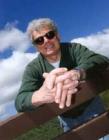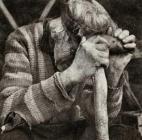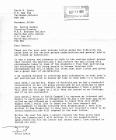1
David Lewis was born in 1946 in Toronto, Ontario as David William Maguire.His common law wife, M. A. Onley, goes by the nickname of Billi.
Solo exhibitions include Relics (2005, Joan Ferneyhough Gallery, North Bay, Ontario), New Work (2004, Joan Ferneyhough Gallery), The Passion Pit (2002, Joan Ferneyhough Gallery), Pigment Images (2001, Sherman Hines Museum of Photography, Liverpool, Nova Scotia), Pictorial Tracts (2000, The Canton Museum of Art, Canton, Ohio), The Lost Art of Bromoil & Transfer (2000, Sherman Hines Museum of Photography, Liverpool, Nova Scotia), Revival of The Bromoil & Transfer Process (1999, The Butler Institute of American Art, Youngstown, Ohio), Pigment Prints (1996, Brazier Fine Art Gallery, Richmond Virginia), Ethereal Images (1994, Naridni Techicke Museum, Prague, Czechoslovakia), Twenty Years in Progress (1989, W. K. P. Kennedy Gallery, North Bay, Ontario), Bromoil & Transfer Images (1981, Deja Vue Gallery, Toronto), Pigment Prints (The Photography Gallery, Bowmanville, Ontario), Keppelland (Owen Sound Public Library, Owen Sound, Ontario), and The People of North Keppell (1976, The Photography Gallery, Bowmanville, Ontario).
His first book is The Art of Bromoil & Transfer (1995; ISBN 0-929116-17-8) and his second book is The Passion Pit (2001; ISBN 0-9730800-0), which features black and white images of the drive-in movie theatre.
His photographs and articles have been published in View Camera, Camera Canada, Photo Life, Photo Vision, Photo Techniques and Popular Photography, as well as other sources.
He is a Master of Photographic Arts (Professional Photographers of Canada), a Craftsman of Photographic Arts (Professional Photographers of Canada and Professional Photographers of America) and President of the American Society of Bromoil Artists.
He is represented by Joan Ferneyhough Gallery (North Bay, Ontario); Rice/Pollack Gallery (Provincetown, Massachusetts); Washington Street Gallery (Lewisburg, West Virgina) and Joe Neil Inc. (New York).
His most recent solo exhibition is Corporate Wasteland at the W. K. P. Kennedy Gallery (2007).
(The biographical information featured here was written in consultation with the artist in 2007.)
Interview:
PHOTOGRAPHER PASSIONATE ABOUT JOB
David Lewis loves photography. The North Bay photographer has been taking pictures for 45 years and has no intention of stopping his life-long passion any time soon. "As long as I can produce good work, I will continue doing it," Lewis said.
Lewis explained that all of his photographic ideas come from his own life experiences, and from general observations, which stimulate his mind. "It just comes to me," Lewis said. "This is a project and it's worthwhile. I don't look for projects, it just happens."
Some of Lewis' work includes photographs of abandoned places, especially old drive-in movie theaters, the inspiration for his book 'The Passion Pit'. It was while working in Prince Edward Island that Lewis first came up with the idea after seeing an abandoned drive-in theater, a dying breed in today's society. Following that encounter, Lewis decided his next project would be of those old abandoned drive-in movie theaters. He dedicated six years of his life to develop, research, conceptualize and work on the photographic project, which led to the eventual publication of a book.
Lewis' interest in abandoned places dates all the way back to his childhood. He explained that he had a very rough life growing up and those emotions are revealed in all of his pictures. "Everything in my work is me," Lewis stated. "The heart and soul in...the work express very well my own feelings." Lewis' passion for photography comes from within himself.
Lewis' pictures all depict themes of vanishing cultures. Vanishing cultures are seen in the abandoned drive-in movie theaters and also in abandoned industrial sites. In addition, Lewis' work also depicts themes of loneliness, anger and a sense of despair. "I had a challenging childhood with no sense of belonging," Lewis explained. "I had a lot of homes and that influences...my work for sure."
Every one of Lewis' photographs has a story behind it. "Every image I printed, I remember the story," Lewis explained. "I can't remember much in life but I can remember all the picture stories."
While growing up, Lewis had no idea what the future would hold for him. There was never a defining moment in life in which Lewis ever thought he would be a photographer. He said photography was something which just happened. "I did it for my own pleasure, a sense of self-satisfaction," Lewis added.
He said the more he gets interested in a particular work, the more he becomes obsessed with it. "I don't need to be motivated," he said, "as time doesn't mean a thing."
Lewis' job as a photographer means the world to him--pictures are his life."I can hardly wait to get up in the morning and start working," an anxious Lewis expressed.
He explained that the most satisfying part of his profession is being able to share with others--especially the general public and aspiring photographers.
Over 45 years of taking pictures, Lewis said he is never satisfied with the final product of his pictures as he is always struggling for perfection. However, throughout his career, there have been only two instances where he knew the moment the image was taken that the pictures were close to perfection.
Most of Lewis' work can be completed in a month's time, while others can take a few days. "No image takes the same time as everyone is different," Lewis said.
Lewis explained he doesn't consciously put emotion in his work, as he likes to let the viewer decide if there is emotion in the photo or not. "Something triggers me when I take the picture and every once in awhile there is emotion in it," Lewis added. " I don't try to put any in it, it just happens."
(By Andrew Hopkins, based on an interview in winter, 2006).
4
Book excerpt (from the Passion Pit)2001
"David is a rare artist with the camera.His images immediately evoke magic and move the viewer to their own private dreams.
David's interest and nostalgia for vanishing cultures and lifestyles have led him to seek out and record the mythical beauty of our familiar yet fast-disappearing landscapes."
Credits:David Lewis


